For me, a good alternative to securing an FBO crew car is bringing my own foldable bicycle. That’s why I was interested to try two new models from Jupiter Bike, which is part of Tampa, Florida-based Daniels Technologies. The company was showing off the goods at this year’s Sun ‘n Fun fly-in.
The two bikes are much different from each other. The JupiterBike Version 2 does not have pedals, uses electric braking and is smaller and lighter than the Discovery bike. The Discovery has greater all-electric range, but with pedals can be ridden when the battery is depleted or for those looking for exercise. Here’s an overview.
Size Matters, Partly
Foldable bikes have been around for decades and my first one was made by Fuji, weighed 45 pounds, and with full-size 26-inch wheels, it awkwardly hinged around the aircraft seat post. It fits easily into the trunk of a car, but required some serious effort to get it into the back of a Cessna 182.
Plus, I was always concerned about getting grease from the chain on the seat fabric, and I used the passenger seatbelts to strap the bike in, making it safe for flight. The usual bike ride into town from the airport was a distance of about 6.5 miles. Since I’m not overly athletic, it was a bit of a workout. Enter e-bikes.
Polymer lithium ion battery technology has changed the off-airport transportation capabilities. The evolution saw small-framed folding bikes designed with small wheels, electric-assisted pedal bikes and all-electric bikes with pedals. With technology concepts taken from the automotive industry, lightweight all-electric bikes are able to perform with surprising speed and agility.
Jupiterbike v2.0
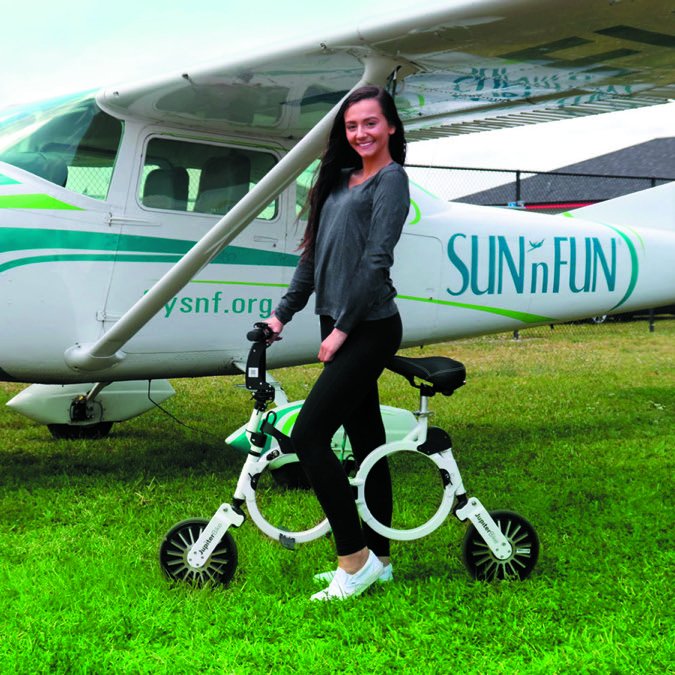
Yes, the latest JupiterBike electric model is small enough to stash in a backpack. This bike is designed with lithium ion batteries in the front wheel and an electric motor in the rear wheel. With 10-inch wheels, a high-capacity battery and a powerful brushless electric motor, speeds of up to 15 MPH are attainable, with a duration of 10 miles-which might not always be long enough.
Thanks to the aluminum alloy frame, the bike weighs in at around 32 pounds. Acceleration is brisk and the bike has good brakes, assisted by the electric motor. There are no brake calipers or other hand brakes. Two electronic switches built into the handles are used for acceleration and braking. The right-hand switch is the accelerator and the left-hand switch is the brake.
JupiterBike’s folding design is unique, with a hinge in the middle of the frame. The wheels unlock and fold inside of the frame, making the bike exceptionally small. It’s sized at 16.3 by 20.5 by 5.75 inches when folded, and 49 by 6.29 by 35.5 inches when unfolded. It’s nearly the perfect size for stashing in a baggage area.
As for performance, since it has a 39-inch wheelbase it’s stable in turns. Heavy riders make note: The aluminum alloy makes the bicycle light, but limits the maximum rider weight to under 220 pounds.
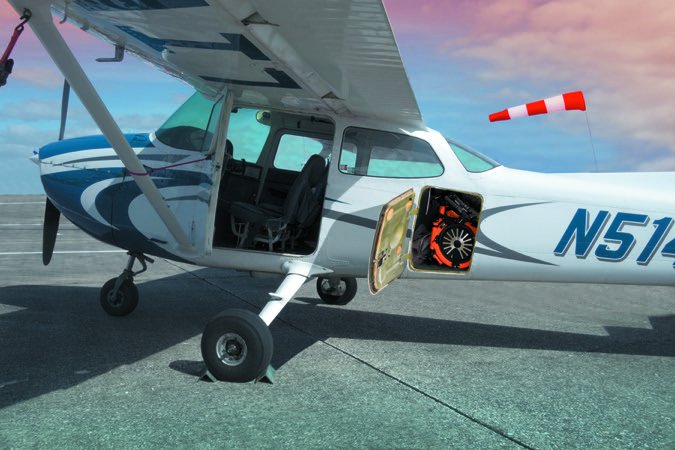
But thanks to ample seat adjustments, the frame accommodates a good range of body heights. For more comfort, the seat can be upgraded-something company President Rob Daniels said most buyers do.
The 13S lithium ion battery, built into the front wheel, delivers 10.3 Wh per cell for a total of 135 Wh. Jupiter Bike offers a replacement front wheel assembly when the supplied batteries reach the end of life. Instead of replacing the battery, just swap the wheel out.
Replacing the front tire requires some effort using a hex wrench, X-Acto knife and pliers. A video that shows the process is at https://tinyurl.com/y2uubhcb.
For charging the batteries there’s a small charging port (and a lighted On/Off switch) on the side of the front frame. The included 100-230 (VAC) AC/DC charger will automatically shut off when the battery becomes fully charged in two hours. You can purchase additional chargers, but be sure to top off the batteries before you go-charging li-ions while airborne is not recommended for obvious reasons.
The JupiterBike V2.0 is priced at $895, includes free shipping within the U.S. and has a one-year warranty, which excludes tire wear. The bike is available in various colors: black (the most popular), orange, green, white and light blue. The trendy orange paint seems best for higher visibility.
An App and Accessories
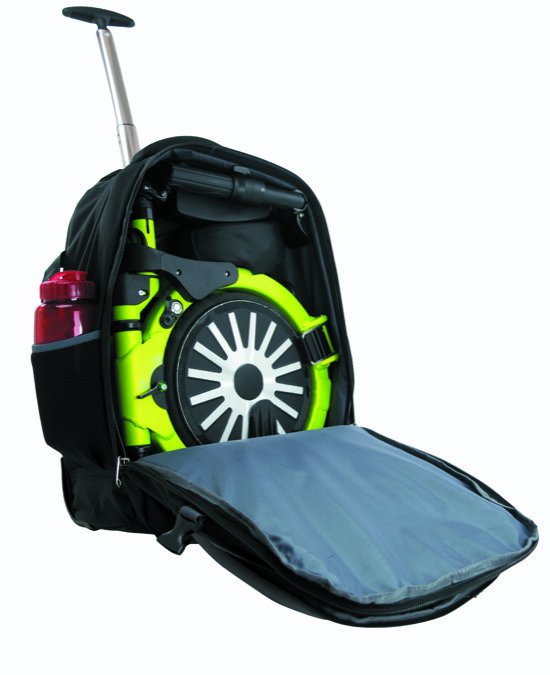
The bicycle works with an app (compatible with Android and Apple smartphones) and the company sells a bracket to hold the phone on the handlebars. The app connects to the bike via Bluetooth and displays a speedometer, battery level, a compass and support information. A speed limiter can be programmed through the app, which might be wise for kids and blue-haired pilots.
A variety of upgrades and accessories are available, which quickly grow the price. There’s a rolling backpack ($89.95), dual spring leather seat with LED taillight ($44.95), universal cross grip smart- phone mount ($24.95), LED front light ($44.95) and the Accessory Pack. It includes a backpack, leather seat, front LED light and a smartphone mount ($179.95). The seat upgrade, which has dual springs, is much wider and softer than the standard seat and is we’ll worth the money, in my view.
A variety of spare parts may be purchased. These include foot rests ($19.95), spare charger ($13.95), front wheel with batteries ($119.95), rear wheel with motor ($119.95), tire tread ($28.95), seat adapter kit with quick release ($15.95) and a standard snap-on seat ($14.95).
It was natural for Jupiter’s Rob Daniels to begin work on the next model. Version 3.0 of JupiterBike will essentially be the Version 2.0 model, but inclusive of all the accessories offered on the website; think of it as a fully loaded model. I’m told that the aluminum frame has been re-engineered to support more weight, or heavier people (only one rider per bike-the handlebars will not support the weight of an additional rider). With Version 3.0 of the bike still under development, few specific details were available at press time.
Using It
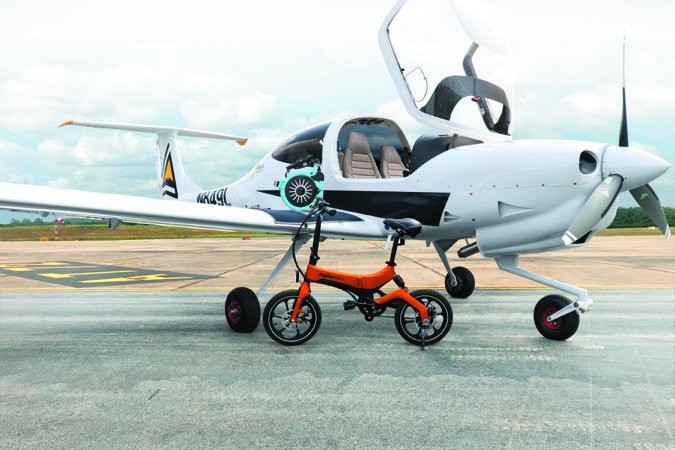
The performance of this compact e-bike is impressive. Test riding the JupiterBike V2.0, I found it to be quite peppy and nimble in the turns. Acceleration was surprisingly quick. The accelerator switch is built into the right handle, while the brake switch is on the left handle. For me, it seemed quite natural, much like a car. The braking of the electric motor delivers rapid deceleration of the bike. Simply releasing the accelerator switch causes the bike to slow down and coast. The brake switch, on the other hand, is for stopping RIGHT NOW, bringing the bike to a stop quite quickly. While I did not try pressing both switches at the same time (braking and accelerating), I expect that you could create some interesting tread marks at the airport.
Folding and unfolding the JupiterBike V2.0 is not complicated. It uses four spring-loaded adjustable cam locks on the wheels and handlebars. The seat uses a friction lock to adjust its height. Finally, a latch on the frame’s hinge locks the frame together.
Unfolding the bike-with a bit of practice-takes about two minutes. It’s worth watching the training video on Jupiter Bike’s website; it walks you through the process step by step. In the short video you can see a professional fold and unfold the bike. In fact, there are a number of videos on the website providing step-by-step instructions for various maintenance items, including replacing the front tire when the batteries need to be replaced.
And of course the usual caveats apply: Wear a helmet and other smart riding gear. Last, before loading the bike in the airplane for traveling, check the municipal regulations for the operation of electric bicycles. In Ontario, Canada, for example (where I often operate) for the e-bike to comply with the Highway Traffic Act it must not weigh more than 120 kg, electrical terminals must be completely covered, the bike must have two independent braking systems, a minimum wheel width or diameter cannot be less than 35 mm/350 mm, it cannot exceed a power output of 500 watts or a speed of 32 km/h and it must have pedals.
Jupiter Discovery
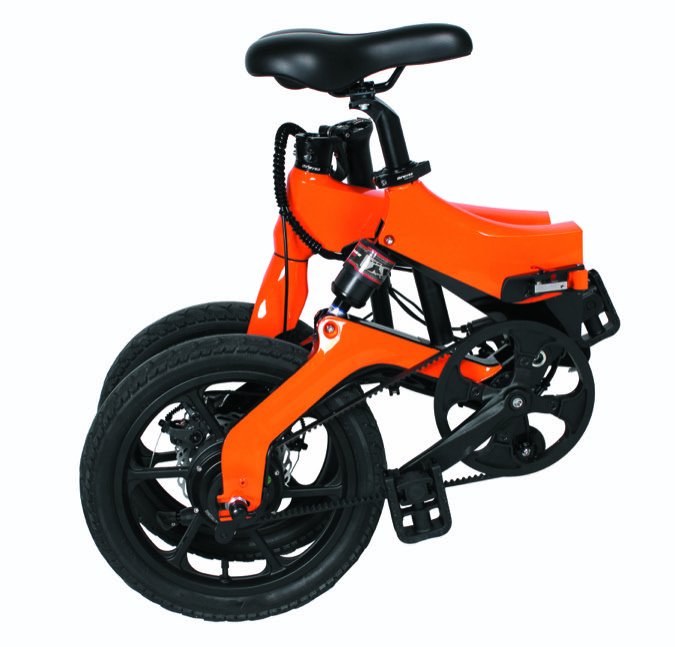
The $1595 Discovery model is a heavier and larger e-bicycle, weighing 42.25 pounds with the battery. With 16-inch inflatable tires, a high-capacity battery and a powerful brushless electric motor, the Discovery turns out speeds of up to 16 MPH, with a duration of 40 miles per charge.
The bike is built around a magnesium alloy frame (it also has a kickstand), which helps keep the weight of the bike down, compared to other traditional bikes. Braking is accomplished by front and rear disc brakes and I found them to be quite effective.
The bike’s folding design has a hinge in the middle of the frame. The Discovery folds in half and has foldable pedals and a removable seat, making the bike compact for its overall size. It measures 30.08 by 25.08 by 16.93 inches when folded, and 52.75 by 34.3 by 21.65 inches when unfolded. The wheelbase is 37.4 inches and it’s stable in turns.
The maximum weight of the rider cannot be more than 265 pounds, which is more than the JupiterBike V2.0 can handle. And like the V2.0, the Discovery’s adjustable seat provides ample height adjustment for a wide range of body heights.
Built-In Electronics, Variable Speed
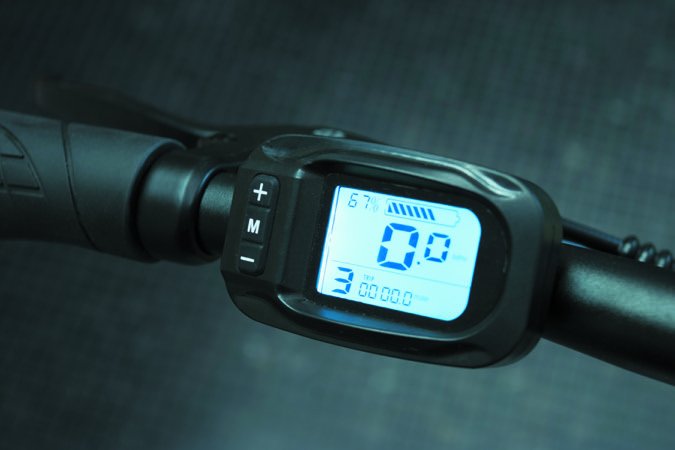
Unlike the app-controlled JupiterBike V2.0, the Discovery has a built-in LCD screen and a three-button user input. The display shows battery life, speed and diagnostic icons. The battery slides into the side of the frame and is accessible when the bike is unfolded.
The Discovery has a built-in front headlight that is controlled by one of the buttons on the display, while the electric motor is controlled by the “M” button on the screen. Pressing this button switches the motor on and off, in addition to changing the bike’s speed: There’s 0, which is pure pedal-power riding with no electric power; 1, which is a low-speed mode (maximum of approximately 8 MPH); 2, which is mid-speed mode (maximum of approximately 11 MPH); 3, which is the high-speed mode of 16 MPH.
The lithium ion DC battery, built into the frame, is a 36-volt, 5.2-Ah battery for powering the 250-watt electric motor. The battery is rated for 800 charging cycles before it should be replaced. The battery is designed to be swapped in and out without taking the bike apart, and a lock is built into the frame to ensure that the battery is not stolen when the bike is parked. Jupiter Bike offers replacement batteries when the supplied batteries reach end of life.
A small charging port and lighted On/Off switch is on the side of the front frame. The included 100-230 (VAC) AC/DC charger will automatically shut off when the battery becomes fully charged in four hours, but should not be charged for longer than six hours.
The Discovery’s spare parts include a spare battery pack ($250), disc brake ($35) and tires ($35 each).
Buy Direct or At Amazon
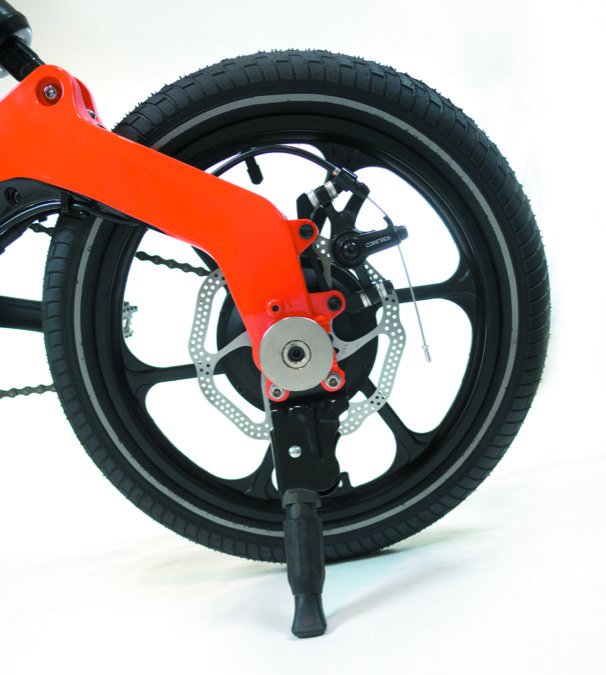
Jupiter sells its e-bikes direct via its webpage (www.jupiterbike.com) or look for them on Amazon. There’s even a 24-month payment plan. With interest the JupiterBike V2.0 is $47 and the Discovery is $84.
I test rode both the JupiterBike V2.0 and the Discovery bike and found them both to be agile and easy to ride. I also like the idea of having pedals to give me some well-needed exercise, while never worrying about a dead battery. With that said, the lightweight frame on the JupiterBike V2.0 is attractive. I’m hoping that in the near future, more states and provinces will allow pedal-less e-bikes on the roads. After riding both, it’s easy to see they are different, which could help the buying decision.
For those who use a bike infrequently and are just looking for improved mobility to and from the airport (less than 10 miles), I think the JupiterBike V2.0 hits all the marks, especially for portability.
It’s priced fairly at $895 and is a worthy option for sightseeing or getting into town when the FBO crew car is otherwise occupied.
Roll Your Own Bike Racks
That’s if you fly an experimental aircraft, which is just what I did for my kit-built Dream Tundra pictured here.
While folding bikes or powered scooters seem to be the normal way of carrying transportation in your personal aircraft, there are other options-especially when you fly a big hulking experimental bush plane that regulations allow you to modify. And if you like to fly that bush plane out into the back country and you want surface transportation when you get there, external bike racks are one answer. This does, however, elicit comments and stares from just about everyone when you pull back up to a fuel pump at a civilized airport. “You really fly with those things on there?” is the most common question, which I find odd, since most of the time, we just landed, so the answer should be obvious.
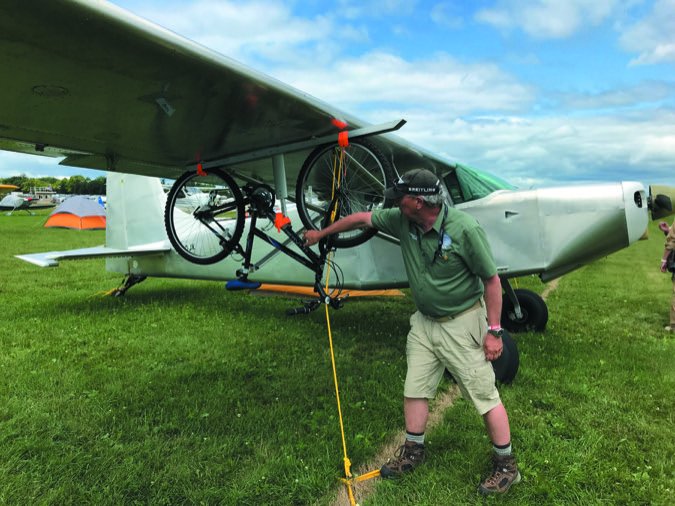
We didn’t invent the idea of carrying external loads-thank our friends in Alaska and Canada for that-and we didn’t even invent the bike racks that we have on our kit-built Dream Tundra. We got the idea (and a set of plans to help us get started) from the folks at Murphy Aircraft, a Canadian kit company that decided their new Radical aircraft model wasn’t quite far out enough, so they hung mountain bikes on the wings and took it to shows. After flying the Radical myself-with bikes hanging out there-I figured it would be a great way for us to haul our own surface transport out into the wilds of our Nevada home.
Starting with a set of plans provided by Murphy, I quickly delved into a few changes due to the availability of materials and tooling. The backbone turned out to be easy to make from a square aluminum tube cut in half lengthwise. The mounting points pick up reinforced areas on the main and rear spars of the wing, just outboard of the strut attachment points. The vertical posts are streamlined aluminum tubing, and the cradle that hugs the bike’s diagonal tube is formed from 4130 steel sheet. The weight of the bike is actually taken by this post and the tires are strapped in to the backbone for stability.
Construction was simple for a multiple-time homebuilder who has a shop full of tools and there was nothing out of the ordinary for fabrication. Of course, we built one for each side to keep things symmetrical, and my wife has the same bike as I do, so weight and (lateral) balance worked out just fine.
Flying with the bikes installed lowers the normally sedate cruise speed from about 115 knots down to 105-there is no getting past the fact that bicycles are draggy. After putting the airplane back in to Phase 1 testing (required for modifications that might change handling characteristics), we flew a full set of stalls with one bike and two, as we’ll as with bare racks. We flew the full range of airspeeds up to redline as well, and noticed no real difference in handling or performance. This is probably a testament to the Tundra being fairly draggy to begin with. I half-expected the airplane to fly like a twin with an engine out with only one bike, but it was, in fact, very we’ll behaved, and there was very little yaw from this configuration.
Hanging your bike outside might seem like a pretty foreign concept, and of course, it is going to take away considerable performance from any kind of fast-moving airplane. But, these rarely have high wings anyway, so racks aren’t an option. But for flying over the nearest mountain and landing on a lakebed in the middle of Nevada, the external bike racks are convenient, and get you where you’re going with REAL mountain bikes capable of handling the back country. For this specialized case, the racks make a lot of sense-even if they do still get a lot of strange looks.
–Paul Dye


